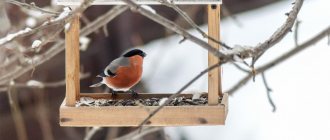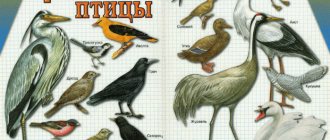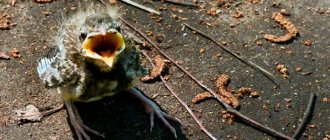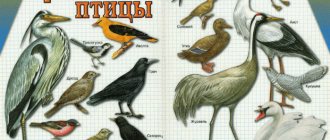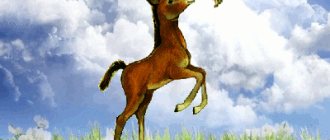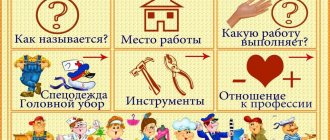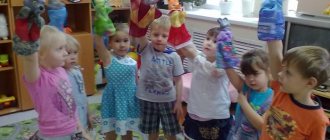Summary of GCD in the senior group of kindergarten. Topic: “Birds of Migratory”
Summary of educational activities for children of the senior group “Birds of Migratory”
Author: Lavrik Elena Stanislavovna, teacher of the preschool educational institution “Nursery-garden No. 316 of Donetsk” DPR
Goal: to develop the ability to establish cause-and-effect relationships, expand ideas about migratory birds, consolidate knowledge about autumn, autumn changes in nature, practice the technique of folding paper figures (origami). Develop cognitive activity, logical thinking, memory, coherent speech, creative imagination, finger motor skills. Cultivate interest in bird life and endurance. Materials: pictures, origami paper, felt-tip pens.
Progress of GCD
The teacher reads the poem by M. Evensen “Autumn”
- What time of year is this poem talking about?
- About autumn. - Why did you decide so? Children's answers. Game “Don’t say yes and no!” * Do the leaves fall in autumn? (fall off). * Does it snow in autumn? (It doesn’t). * Do icicles hang in autumn? (not hanging). * Do people sunbathe by the river in autumn? (do not sunbathe). * Do animals prepare for winter in autumn? (getting ready). * Do birds fly to warmer climes in autumn? (fly away) - What else happens in the fall? — In autumn it often rains, people take umbrellas. — In autumn, the days become shorter and the nights longer. — In autumn, people harvest vegetables and fruits. — In autumn, mushrooms grow in the forest and mushroom pickers collect them. — In autumn, insects hide under the bark of trees. — Cold winds blow in autumn. - Do you want to know what we will talk about today? - Yes. — Guess the riddle: They can fly, their down and feathers keep them warm. Who is this? - Birds. - Name the body parts of birds (head, beak, body, legs, wings, tail). What is a bird's body covered with? (feathers) - What are feathers for? (so that the birds do not freeze and injure their bodies) - What is the tail for? (helps to maintain balance, turn in flight) - All birds have the same structure, they all have a head, beak, feathers, wings, tail, but why do people call them differently? Children's answers.
— Birds differ in appearance, plumage, and size.
—What do you call birds that fly to warmer climes? (migratory) The teacher shows pictures and talks about birds. * Swallow is smaller than a sparrow, the color of the feathers is dark, the breast is white, the wings are wide, the tail is forked. Swallows catch mosquitoes, midges and other insects. * The starling is a large, beautiful bird with shiny black plumage. The beak is straight, long, and helps to extract worms from the ground. * The rook is a medium-sized bird, black with a purple tint. Exterminates harmful insects. * The crane is a large bird with silver-gray plumage. The wings are large and strong. Long thin legs, a long beak and neck are necessary for the crane to live in the swamp. When the nights become longer and colder, the cranes gather in flocks and prepare to fly to warmer climes. * The swan is a beautiful, graceful, proud bird. The plumage is dazzling white. The beak is red, the feet are webbed to make swimming easier. Swans feed on leaves, plant stems, grass, and small aquatic life. When water bodies become covered with ice, swans fly south. * Wild duck - medium size, gray-brown in color. The color of the drake is bright and elegant. Lives on lakes and rivers. It feeds on duckweed, bugs, worms, and larvae. Ducks are the last to fly when rivers and lakes freeze. Game “Finish the sentence” - The duck is gray, and the swan... - The crane is large, and the swallow... - The swan is white, and the starling... - The rook is a migratory bird, and the crow... Physical exercise "The swallows flew..." - Guys, do you know why birds fly away to warmer climes? (cold weather is setting in, it’s difficult to find food, there are no insects in winter) - How do you think birds find their way to the south and back? Children's guesses.
— Some birds fly away at night, others during the day.
Before flying south, they make test flights, eat a lot, accumulate fat - they have nowhere to eat during the flight. Birds are guided by the stars, and if the sky is overcast and no stars are visible, then they are guided by the magnetic vibrations of the Earth. — Guys, why do you think people say: * Every bird is proud of its feather. * Each bird has its own habits. * The crane flies high, but does not fly away from the river. Children express their opinions. Game “The Fourth Wheel” * crane, rook, chicken, swallow. * bear, fox, swan, hare. * duck, starling, crow, swan. * dove, sparrow, swallow, tit. “The birds have flown away to warmer lands, but so that we don’t feel sad, let’s make beautiful birds out of paper.” But first, let's prepare our fingers. Finger game “Bird” 1. Place a square in front of you with the angle up. Fold it in half, lifting the bottom corner.
2. You get a triangle, a “kerchief”, bend it in half.
3. Unfold and lower one corner (the first layer of the scarf) so that it extends slightly beyond the bottom side.
4. Bend the piece in half.
5. Bend the corners (wings) in different directions.
6. Draw the eye and beak. — Guys, did you like our lesson? What do you remember most? What will you tell your parents when you get home?
We recommend watching:
Summary of a lesson on the surrounding world in the senior group. Why do leaves turn yellow in autumn?
Similar articles:
Conversation in kindergarten on the topic “Migratory birds” in the preparatory group
A story about a pigeon, grades 1-2. The world
A story about a canary for children, grades 1-2
Coloring pages "Migratory birds" for children with names
About migratory birds for children 5-6 years old
Migratory birds, lesson notes on getting to know nature
Summary of a lesson on familiarization with nature in the senior group, topic: “Migratory birds”
Author of the lesson: teacher of the highest category Sorokina A.M., Tolyatti.
Goals:
1. Introduce children to the concepts: “flying in a wedge”, “chain”, “flock”. 2. Expand and consolidate children’s ideas about migratory birds: stork, cuckoo, nightingale; about the body parts of birds. 3. Exercise children: - in the formation of complex adjectives; - in composing complex sentences. 4. Cultivate in children a kind attitude towards all living things in nature.
Equipment:
Illustrations of migratory birds, audio recordings of bird voices and singing.
Preliminary work:
Bird watching while walking; reading poetry, stories about birds.
Progress of the lesson:
1. The teacher reads a poem by A. Pleshcheev:
Boring picture! The clouds are endless, The rain keeps pouring down, Puddles by the porch,
Stunted rowan gets wet under the window; The village looks like a gray blur.
Why are you visiting us early, Autumn? The heart also asks for Light and warmth.
— Guys, please tell me what time of year the poem is talking about? /About autumn/
— Please name the characteristic signs of autumn? /The foliage turns yellow, it drizzles, the birds fly away/. —What are the names of the birds that fly to warmer regions and those that stay? /Migratory and wintering/. - Name the migratory birds? /Swallow, woodpecker, rook, heron, crane, starling, lark/. — Please guess the riddles:
1. This bird never builds nests for chicks. /Cuckoo/
- Listen, please, to how the cuckoo calls. /audio recording/. Guess the next riddle.
2. Under the roof I make a nest out of lumps of clay. For the chicks I put a downy feather bed on the bottom. /Swallow/ /audio recording starts/
3. This is an old friend of ours: He lives on the roof of the house - Long-legged, long-nosed, Long-necked, voiceless. He flies to the swamp to hunt for frogs. /Stork/ /audio recording/
- You guessed correctly, these birds are also migratory. The nightingale is a small bird with brown plumage, a small beak, tail and legs. The cuckoo is a small bird, but larger than the nightingale, has a variegated color, a long tail, and a small beak. The cuckoo, unlike other birds, never makes nests, but lays its eggs in other people's nests, so the birds are forced to hatch and raise cuckoo chicks. The stork is a large white bird with a large beak. — Please name the body parts of birds. /torso, head, tail, beak/. - All birds have the same structure, but people call them differently, how do they distinguish them? /By plumage, appearance, size/ - Guys, why do birds fly to warmer climes? /Because it gets cold here, there are no insects in winter/. - How do they find their way to the south and back here? /we don’t know/. It turns out that some birds fly away at night, others during the day. But before the flight, they make test flights, eat more than usual, put on fat - there is nowhere for them to eat during the flight. In flight, they are guided by the stars, and if the sky is overcast and the stars are not visible, then they are guided by the magnetic oscillations of the Earth. Have you noticed that some birds fly away in “flocks”, all together; some, for example, cranes, line up in a “wedge” in the form of a triangle; others line up in a “chain”, in one line. It probably depends on the habits of the birds: some birds need leaders who show the way.
Physical exercise “Birds”
/fingers of both hands bend/
Sing along, sing along, Ten birds are a flock, This bird is a sparrow, This bird is an owl, A sleepy little head. This bird is a waxwing, This bird is a corncrake, This bird is a starling, A gray feather. This one is a finch, This one is a swift, This one is a cheerful siskin. Well, this one is an angry eagle, Birds, birds, go home. /hands behind back/
Exercise “Guess and sit down”
- Guys, now I will name migratory and wintering birds, if you hear the name of a wintering bird, then sit down; and if the name is migratory, then wave your hands. Crow, nightingale, woodpecker, magpie, dove, swallow, tit, rook, starling, bullfinch, stork, crane, sparrow, heron, etc.
Exercise “Say in one word”
- Guys, please stand in a circle. I will throw the ball to you, and you will return it to me with an answer.
The stork has long legs, what is it like? ... /long-legged/. The stork has a long beak, it is... /long-billed/. The swallow has a long tail, it is... /long-tailed/. The swallow loves warmth, she is ... /heat-loving/. The swallow has sharp wings, it is... /sharp-winged/. The nightingale has a ringing voice, he... /clear-voiced/.etc.
Exercise “Continue the sentence, find the reason”
Birds that feed on insects are the first to fly south in the fall, because... /insects are hiding and they have nothing to eat/. The woodpecker can be called a forest doctor because .../he takes out bugs and insects from under the bark/. The cuckoo does not hatch its chicks because .../it does not build its own nests/. All people love to listen to the nightingale, because .../he sings beautifully, bursts into song/. etc. In the spring, migratory birds fly back because... /they need to hatch their chicks/.
Lesson Analysis:
— Guys, please tell me what we talked about in class today? — What new migratory birds did you learn about? — What interesting things did we learn about the cuckoo? - How do they find their way to warmer regions and back to us? — Guys, I liked the way you worked in class: you listened carefully, thought, and answered in complete sentences. Well done! I give prizes to the most active guys.
Download lesson notes “Migratory Birds”
vospitatel.com.ua
